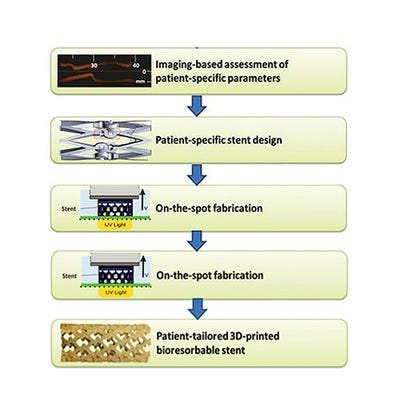October 12, 2016
Customized implantable medical devices continue to advance--this time with flexible, 3-D printed stents designed for each patient's specific needs.
Joyce Laird
 Medical technology is pushing the 3-D printing envelope at the Northwestern McCormick School of Engineering, where researchers have created biodegradable stents customized to fit a specific patient's body using 3D technology.
Medical technology is pushing the 3-D printing envelope at the Northwestern McCormick School of Engineering, where researchers have created biodegradable stents customized to fit a specific patient's body using 3D technology.
Stents are designed using various metals. While available off the shelf in many sizes, perfect fit is always an issue. "The physician has to guess which stent size is a good fit to keep the blood vessel open. But we're all different and results are highly dependent on physician experience, so that's not an optimal solution," says Guillermo Ameer, a biomedical engineering and surgery professor at Northwestern who worked on the project with Cheng Sun, an associate professor of mechanical engineering.
To create these customized stents, Ameer worked with Sun to adapt a 3-D printing technique, called projection micro-stereo-lithography, to fabricate stents using a polymer previously developed in Ameer's lab. The technique uses a liquid photo-curable resin or polymer to print objects with light. When a pattern of light is shined on the polymer, it converts it into a solid that is then slowly displaced to cure the next layer of liquid polymer. The printing technology allows the team to fabricate a stent that precisely matches desirable design characteristics.
Sun's 3-D printing technique has several advantages. He explains that first, it is extremely high resolution. With the ability to print features as small as 7 microns, it is perfect for printing stents, which have very fine mesh dimensions and can be smaller than 3 mm in diameter. Second, it has the ability to print up to 100 stents at a time, producing them faster and potentially cheaper than traditional manufacturing methods. Third, it's fast, printing a 4 cm stent in a matter of minutes.
Current stents are made of metal wire mesh, by Ameer used a citric-acid based polymer developed in his lab. The resulting stent is flexible, biodegradable, and has inherent antioxidant properties. Drugs can also be loaded onto the polymer and slowly released at the implantation site to improve the healing process in the vessel wall. Ameer has previously shown that the polymer can be engineered to inhibit clot formation when applied to vascular grafts.
Ameer and Sun imagine a future process whereby the dimensions of a patient's vessel are obtained using standard imaging techniques available at all hospitals, allowing a stent to be printed on site for immediate surgical implantation.
Next, Ameer plans to investigate how long it takes for his biodegradable stent to break down and absorb into the body. His team also aims to investigate innovative stent designs to improve their long-term performance.
"Not only can we customize the stent for a patient's blood vessels," he said, "but we can create all new types of patient-specific medical devices that could make the outcomes of surgical procedures better than what they are today."
Ameer and Sun's research is supported by the American Heart Association and is published in the journal Advanced Material Technologies.
3D-Printing Vascular Stent from Northwestern Engineering on Vimeo.
Joyce Laird is a contributor to Qmed.
Like what you're reading? Subscribe to our daily e-newsletter.
[Graphic is public domain, courtesy of Northwestern McCormick School of Engineering]
About the Author(s)
You May Also Like


